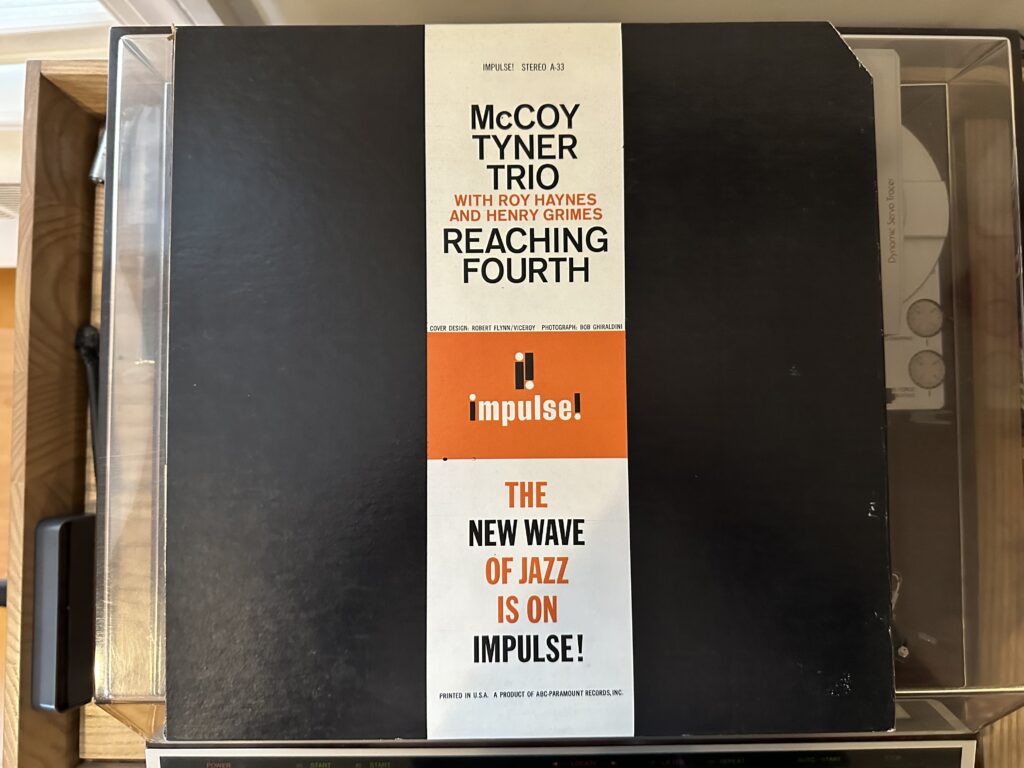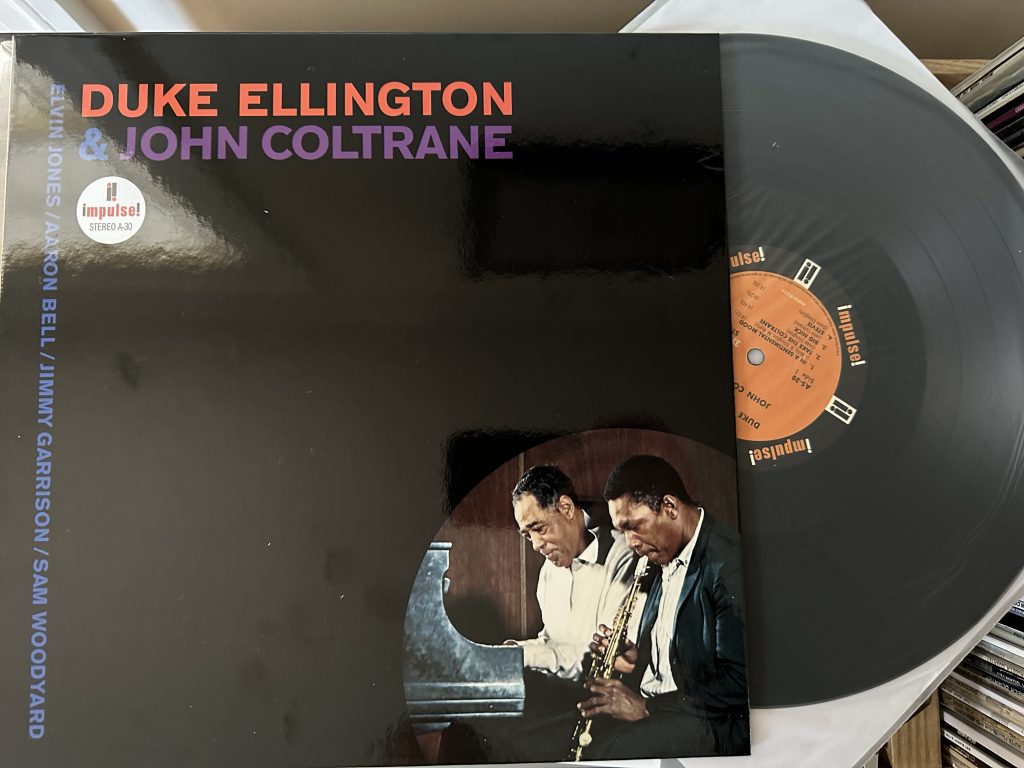
Album of the Week, January 27, 2024
The repercussions of John Coltrane’s reach into avant-garde jazz, and subsequent backlash from some critics, can be traced in his early career in the 1960s, as albums after Africa/Brass took a different approach and recordings from the 1961 residencies went unpublished for several years. It’s tempting to read McCoy Tyner’s Impulse! recordings through the same lens, imagining that his substantial talents in forcefully modal jazz were suppressed by the label. Some critics have read the early Tyner recordings as evidence that he was insufficiently innovative for Coltrane’s group, foresaging his eventual departure.
The truth of the matter appears to have been mundanely commercial. Creed Taylor had left Impulse! in the summer of 1961, and his successor, Bob Thiele, asked Tyner to record more straightforward jazz albums. —I should note something about the classic Impulse! recordings before I go any further. Like Blue Note before it and CTI after, Impulse! under Taylor and his successors created a distinctive graphic identity through the use of photography, typography, design, and the overall excellence of the physical package, and Reaching Fourth is no exception. Released in a gatefold cover with striking photography and text against a black background, and the orange, black and white “house style” design on the back, it’s a gorgeous package, and the design holds up even in my 1974 reissued copy.

Whatever the impetus of the album, Reaching Fourth is a mix of standards and intriguing Tyner originals, recorded as a trio with bassist Henry Grimes and drummer Roy Haynes. Grimes, who would go on to build an important career in free jazz as a member of groups led by Pharaoh Sanders, Steve Lacy, Cecil Taylor, Don Cherry, and others had come to fame at the 1958 Newport Jazz Festival and its accompanying documentary, Jazz on a Summer’s Day. Word spread about his amazing playing and he ended up playing with six different groups throughout the festival. Haynes, who had been playing since his debut in his native Boston in 1942, had recorded with Charlie Parker, Lester Young, Bud Powell, and Sarah Vaughan. (He is still going strong; his 95th birthday party in 2020 was cancelled due to COVID-19. I saw him play in that same 1993 jazz festival at UVA, where he clearly could outplay all the young musicians in his band.)
The title track is a Tyner composition that seems designed to showcase the more imaginative side of his writing and performance. It bears some of his early hallmarks—unusual modal voicings, a brisk tempo, high velocity runs. But it also benefits from the excellence of his collaborators. Haynes’ drumming stays on the off beat and punctuates Tyner’s solo with brisk snare rolls, while Grimes’ fiercely percussive plucked accompaniment turns into a fiery bowed solo. Haynes trades eights with both Grimes and Tyner, exploring the full tonal color of his kit in the process.
“Goodbye”, written by Gordon Jenkins after the death of his first wife, changes the pace to a meditative rumination. The tune and chords swing from minor in the verse to major in the chorus and back, as though discovering different facets of grief in each new bar. Tyner’s playing has a sensitive touch even as he traces the contours and changes of the tune, and Haynes and Grimes are quietly supportive. It’s a deep sigh of a tune.
“Theme for Ernie,” written by guitarist Fred Lacey for saxophonist Ernie Henry, is a bubbly tune that’s given a bouncy reading. Tyner’s playing pulls at the corners of the melody with brisk runs, accompanied by Grimes at his most buoyant. Grimes’ solo is melodically indebted to Scott LaFaro; indeed, this track brings to mind some of the telepathic interchange between LaFaro and Bill Evans on their trio recordings.
Tyner’s other original, “Blues Back,” is a straight blues, and Grimes especially plays it straight, sounding each note as though tolling a bell. Tyner, by contrast, shows how this blues swings into different modes almost with every measure, even creating a Mixolydian counter-melody in the fourth chorus of his solo. Grimes takes a two-chorus solo that explores some of Tyner’s melodic ideas before the trio returns to the theme once more.
“Old Devil Moon” (which the track listing tells us is from the 1947 Broadway show Finian’s Rainbow) is more commonly remembered as a tune in Frank Sinatra’s catalog; before Sinatra, Miles recorded it in 1953 on his Prestige Records release The Miles Davis Quartet. Tyner takes the tune in a completely different direction, opening with a modal progression between bass and piano, before returning to the main melody. Grimes’ bass line remains constant between the more traditional sections and the modal interludes, providing a pedal point against which Tyner stretches the melody. Haynes helps the forward motion, keeping a steady rhythm with a little trip against the snare in the fourth beat of each measure. Together, the group seems to lean from the straight and narrow into more exciting territory, then to settle back into the straight paths as though with a grin.
“Have You Met Miss Jones” closes out the album; Tyner takes the Rodgers and Hart classic from 1937’s I’d Rather Be Right and dispatches it at breakneck speed. In the coda, Grimes plays octaves around which Tyner improvises a modal melody, wrapping up the whole thing in less than four minutes. It’s a remarkable exercise in economy and a lot of fun too.
After listening to Tyner’s early work with Coltrane, listening to his early trio recordings for Impulse! can initially feel like a step back to an earlier, simpler conception of jazz. Reaching Fourth repays careful listening, showing off his innovative ear and unique compositional gifts; we’ll hear more of both as we listen to more of the recordings in the catalog. Next week we’ll pick up Coltrane’s story where we left off, finding him in a very different territory than the New York clubs that hosted his last explorations.
You can listen to this week’s album here:

